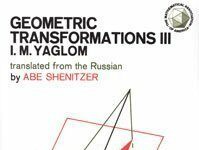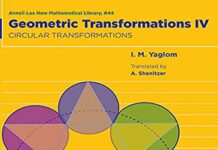
Ebook Info
- Published: 1962
- Number of pages: 133 pages
- Format: PDF
- File Size: 5.19 MB
- Authors: I. M. Yaglom
Description
Almost everyone is acquainted with plane Euclidean geometry as it is usually taught in high school. This book introduces the reader to a completely different way of looking at familiar geometrical facts. It is concerned with transformations of the plane that do not alter the shapes and sizes of geometric figures. Such transformations play a fundamental role in the group theoretic approach to geometry. The treatment is direct and simple. The reader is introduced to new ideas and then is urged to solve problems using these ideas. The problems form an essential part of this book and the solutions are given in detail in the second half of the book.
User’s Reviews
Editorial Reviews: About the Author Issac Moisevitch Yaglom graduated from Sverdlovsk University in 1942 and received his Candidate’s Degree in 1945. He then moved onto the Moscow State Pedagogical Institute since 1957 and is the author of many scientific publications.
Reviews from Amazon users which were colected at the time this book was published on the website:
⭐The Yaglom geometric transformation books are aimed at a mathematical Olympiad audience. The books are not primarily about transformations, they are mainly about how to use transformations to solve problems. Yaglom wrote the book in Russian back in the fifties, presenting geometrical transformations techniques to geometric problem solving. He introduces transformation types and then shows how they can be used to solve problems that otherwise would sometimes be almost unsolvable using elementary (synthetic) methods. Then he presents a set of problems that vary from difficult to fiendish. Full solutions are provided, you will need them. The Russian book has chapters on congruence, similarity and projective transformations that are contained in the three English translations published by the MAA. It continues with sections on inversion transformations that are not (yet?) translated into English.This is the first of three books, it deals with congruence transformations. Examples of congruence transformations are reflections in a line or in a point and translations (parallel movements). One could make up a set of problems that can be solved by simply applying a convenient transformation, but that is not how Yaglom works. Most problems use one ore more other themes (tricks) besides a transformation. So let this not be your first geometry problem book.These are great books for problem solving.
⭐An intelligent book, at last!
⭐Geometric Transformations is a wonderful book teaching geometry from a modern perspective – using Geometric transformations. The three construction problems author mentions in the Introduction appear to be very different but he shows that there is a unifying theme connecting them – he solves all the three problems in a most natural way with very a few lines of proof. You are amazed at the beauty of the argument and wonder why you are not introduced to Geometry in this natural way.On the whole a very enjoyable book. I wish every school teacher teaching Geometry should read – better – master this book. Then he/she can tranmit the joy of Geometry to the students.
⭐This is an excellent introduction to geometric transformations. It is very useful for Competitions such as the AIME USAMO and IMO. Also, it is a great book for those interested in Mathematics.
Keywords
Free Download Geometric Transformations I (Number 8) in PDF format
Geometric Transformations I (Number 8) PDF Free Download
Download Geometric Transformations I (Number 8) 1962 PDF Free
Geometric Transformations I (Number 8) 1962 PDF Free Download
Download Geometric Transformations I (Number 8) PDF
Free Download Ebook Geometric Transformations I (Number 8)


